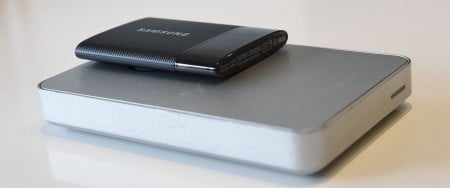Overall, it’s hard not to be impressed with what Samsung has built in its T1 external drive, with the company taking its already established foothold in the solid-state drive market and just making it a little more useful for everyone else, and by “everyone else” we mean anyone who wants an external drive, which is pretty much everyone out there.
But there are three things we noticed about the T1 that have to be acknowledged: setup, connections, and price.
First, the setup, and while regular external drives allow you to take the drive out and start using it, backing up until your heart and mind are content, the T1 SSD requires you to go through an app before you can do anything.
It’s not a thoroughly complicated or difficult app, mind you, with compatibility offered for both a Mac and Windows PC, and the program asking you to name your new external drive and if you want some password security on it, formatting the drive for those specifics, usually to ExFat, which is a format we approve of since it will be compatible with both Windows and Mac for files over 4GB.
That being said, once you’ve gone through the setup, the drive is good to go, and ready to be loaded with files.
You’ll also find a small app installed on your computer whether you like it or not, activating when the drive is plugged in, and allowing you to see the space offered by the drive, serial number, and even if you want to add that extra layer of security with a password.
Interestingly, the setup is easiest on a PC, which just works right off the bat, while the Mac version not only requires an extra not included driver, but also Samsung’s app. Once the app is loaded on either, you’ll find you can set the drive up, and even tie a password to it, which every Windows machine should be able to load the software of easily, while a different Mac (different because you didn’t set the drive up on that computer) will need to load the extra drivers.
That said, it’s pretty seamless and simple to use, and you can access the drive on either operating system once the password is in place, just don’t expect to look at a password protected Samsung T1 SSD on any other operating system, as you news that app to make it work.
Next up is connections, or more specifically, “connection”.
Just like many an external drive, the only way to talk to the Samsung T1 is through the included short USB 3.0 connector, which is a perfect fit not just because it’s small and light, but because it even manages to outweigh the drive itself.
That being said, we’d have liked to see a USB Type C cable in the box, as it would provide people with uber new computers a way of getting the super-fast solid-state portable an easier way to get the drive plugged into their machine rather than going through a converter.
It stands to reason that Samsung will probably market this to the people who don’t mind spending on super new technology, and those are likely the same people who are spending big on devices like the Apple MacBook and Chromebook Pixel, both with the USB Type C connector.
Granted, the USB 3.0 connector is immensely useful, and fairly standard too, but given that the T1 feels like it was engineered for people with new ultralight computers keen to carry as little weight with them as humanly possible, a Type C connector would have made sense.
Maybe in version 2.0. Maybe.
Finally there’s the price, and this is both a positive and a negative.
We’ll start with the latter, because at $429, most won’t see the value.
Dead set, this external drive offers 500GB for the cost of what a 4TB external notebook drive offers, which is a very different capacity altogether. That’s enough to stop a lot of people in their tracks, simply because most people expect to get a lot for their dollar these days, not less.
Though for what it’s worth, we actually expected the Samsung T1 would cost closer to $699 when we started reviewing it, and that leads us to the positive marks.
Simply put, it’s a tremendous value for what you’re getting, amount to one of the smallest, lightest, and fastest drives you’ll ever see, because it is literally one of Samsung’s solid-state drives made portable.
That makes it super fast and super reliable, and that weight — or lack thereof — is just staggering.
So while you might baulk at the $429 tag price and go “nah, that’s not a value”, it’s more or less a first reaction, because the speed and quality provided outweigh that dollar-per-gig value.

Conclusion
While the $429 price might seem like a lot, especially in comparison to standard portable hard drives which can provide as much as 4TB — six times the storage — for roughly the same price, you can’t go past the speed, size, and weight of Samsung’s T1 portable solid state drive.
And if you can, you’re from the future, that’s all there is to it.
Samsung’s T1 is just simply amazing, and if you like your peripherals impossibly light and so very fast, fast enough that even The Flash would have trouble keeping up, the T1 drive has to be checked out.
This is what external drives should be. Highly recommended.














So if you need an app to access it, I presume you cant use it as a boot disk to run linux from.
Haven’t tried. You need an app to set it up, either on Mac OS X or Windows. Presumably, you’d need to set it up on one of these operating systems and then it should work on Linux, though just make sure not to make it password protected.